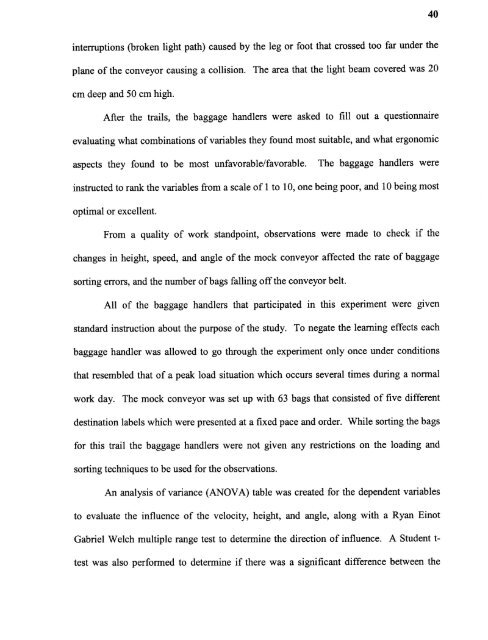An ergonomic assessment of the airline baggage handler
An ergonomic assessment of the airline baggage handler
An ergonomic assessment of the airline baggage handler
Create successful ePaper yourself
Turn your PDF publications into a flip-book with our unique Google optimized e-Paper software.
40interruptions (broken light path) caused by <strong>the</strong> leg or foot that crossed too far under <strong>the</strong>plane <strong>of</strong> <strong>the</strong> conveyor causing a collision. The area that <strong>the</strong> light beam covered was 20cm deep and 50 cm high.After <strong>the</strong> trails, <strong>the</strong> <strong>baggage</strong> <strong>handler</strong>s were asked to fill out a questionnaireevaluating what combinations <strong>of</strong> variables <strong>the</strong>y found most suitable, and what <strong>ergonomic</strong>aspects <strong>the</strong>y found to be most unfavorable/favorable. The <strong>baggage</strong> <strong>handler</strong>s wereinstructed to rank <strong>the</strong> variables from a scale <strong>of</strong> 1 to 10, one being poor, and 10 being mostoptimal or excellent.From a quality <strong>of</strong> work standpoint, observations were made to check if <strong>the</strong>changes in height, speed, and angle <strong>of</strong> <strong>the</strong> mock conveyor affected <strong>the</strong> rate <strong>of</strong> <strong>baggage</strong>sorting errors, and <strong>the</strong> number <strong>of</strong> bags falling <strong>of</strong>f <strong>the</strong> conveyor belt.All <strong>of</strong> <strong>the</strong> <strong>baggage</strong> <strong>handler</strong>s that participated in this experiment were givenstandard instruction about <strong>the</strong> purpose <strong>of</strong> <strong>the</strong> study. To negate <strong>the</strong> learning effects each<strong>baggage</strong> <strong>handler</strong> was allowed to go through <strong>the</strong> experiment only once under conditionsthat resembled that <strong>of</strong> a peak load situation which occurs several times during a normalwork day. The mock conveyor was set up with 63 bags that consisted <strong>of</strong> five differentdestination labels which were presented at a fixed pace and order. While sorting <strong>the</strong> bagsfor this trail <strong>the</strong> <strong>baggage</strong> <strong>handler</strong>s were not given any restrictions on <strong>the</strong> loading andsorting techniques to be used for <strong>the</strong> observations.<strong>An</strong> analysis <strong>of</strong> variance (ANOVA) table was created for <strong>the</strong> dependent variablesto evaluate <strong>the</strong> influence <strong>of</strong> <strong>the</strong> velocity, height, and angle, along with a Ryan EinotGabriel Welch multiple range test to determine <strong>the</strong> direction <strong>of</strong> influence. A Student t-test was also performed to determine if <strong>the</strong>re was a significant difference between <strong>the</strong>
















